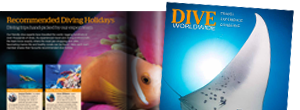Underwater Photography Tips

The underwater world is beautiful, diverse and unlike anything you can see on land. Photographing this incredible world can be complicated, but if done properly the results can be breathtaking!
The team here at Dive Worldwide are all keen underwater photographers, and have compiled their top tips to help budding photographers get started…

Buy a few bits of equipment
Investing in a few accessories for your camera can drastically improve your photos underwater.
Buy a red filter. Colours become lost the deeper you go, so this filter will bring your photos back to a more natural colour, and it saves the need to invest in an expensive strobe. If you have got the cash however, do invest in a strobe! These are miracle makers for photos and will restore natural colour to your photos.
Invest in a tray for your setup, this will help to stabilise images and give you a basis for adding things like arms and strobe accessories. Dome lenses widen your field of view, allowing you to make the most of wide-angle photo opportunities like mantas, sharks and reefscapes. You can even get dome lenses for compact setups that screw onto the housing depending on the configuration.
Always carry spares, you never know what may happen when travelling, so don’t miss a precious opportunity because of one simple part of your equipment breaks or gets lost.
 Perfect your diving before jumping in with a camera
Perfect your diving before jumping in with a camera
An important part of being a good photographer starts with being a good diver. Make sure your buoyancy is in control and you are confident in your diving ability before considering taking down a camera with you.
While photographing, you need to ensure that don’t disturb the ocean floor. Silt and water movement can ruin your shot as well as damage the habitat of your subject. If you need to, take a buoyancy course to help you with propulsion techniques and proper weighting.
 Get to know your camera & equipment
Get to know your camera & equipment
Use your camera as much as possible on land before taking it underwater, and make sure you are comfortable will all the controls and settings. Once underwater, the best way to learn is by practising. Try out different settings, angles and compositions to work out what you think works best for you and creates the results you want.
 Get close & use the natural light
Get close & use the natural light
Get as close as possible, think you’re close enough, you’re probably not! Without touching or disturbing anything, try to reduce the amount of water between you and your subject. Use the natural light from the surface to guide the angle of your photos. If possible shoot slightly upwards and with the light behind you to increase the amount of light on your subject.
Enjoy the dive
Don’t get too caught up in trying to get the perfect shot that you miss the beauty of the dive. Enjoy the dive and your surroundings while taking a few photos of what you see, instead of snapping every few seconds.
 Be aware of the marine life
Be aware of the marine life
Most importantly, be respectful. It’s their environment, not ours! Put the wellbeing of the marine life first when photographing. Never harass or disturb marine life to get a shot, there will always be a better one around the corner.
Resist taking photos of an animal if it looks intimidated by your presence, not all animals react well to flashing strobes or lights in their face, so stop and move away if your subject looks threatened or uncomfortable.
 Learn from the experts
Learn from the experts
Join one of our expert led trips and learn about underwater photography in a beautiful location from an underwater photography specialist! Marine biologist and photographer Dr Richard Smith is leading a trip to photograph the critters of the Lembeh Strait in Indonesia, and conservationist and underwater multimedia specialist Danny Copeland is leading a trip to encounter the whale sharks in St Helena.
Contact us to find out more about underwater photography or any of our expert led trips.








